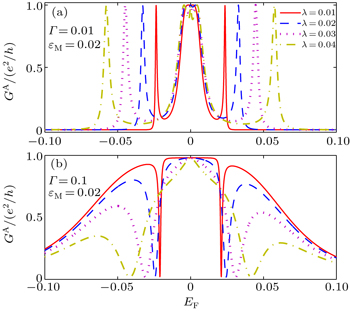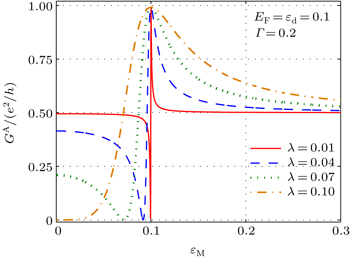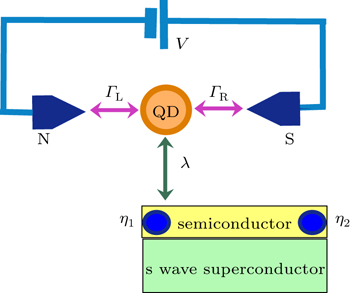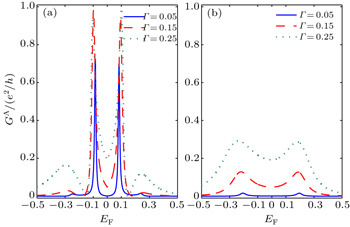† Corresponding author. E-mail:
Project supported by the National Natural Science Foundation of China (Grant Nos. 61176089 and 10974043), the Natural Science Foundation of Hebei Province, China (Grant Nos. A2011205092 and 2014205005), and the Fund for Hebei Normal University for Nationalities, China (Grant No. 201109).
Andreev reflection (AR) in a normal-metal/quantum-dot/superconductor (N–QD–S) system with coupled Majorana bound states (MBSs) is investigated theoretically. We find that in the N–QD–S system, the AR can be enhanced when coupling to the MBSs is incorporated. Fano line-shapes can be observed in the AR conductance spectrum when there is an appropriate QD–MBS coupling or MBS–MBS coupling. The AR conductance is always e2/2h at the zero Fermi energy point when only QD–MBSs coupling is considered. In addition, the resonant AR occurs when the MBS–MBS coupling roughly equals to the QD energy level. We also find that an AR antiresonance appears when the QD energy level approximately equals to the sum of the QD–MBS coupling and the MBS–MBS coupling. These features may serve as characteristic signatures for the probe of MBSs.
A Majorana particle is a fermion that is its own antiparticle and obeys novel non-Abelian statistics, which was proposed by Majorana in 1937.[1,2] Due to their potential applications in topological quantum computation and because of their fundamental interest, Majorana fermions are currently attracting increased attention.[3–9] Recently, it has been reported that Majorana bound states (MBSs) can be realized at the ends of a one-dimensional p-wave superconductor; the proposed system is a semiconductor nanowire with Rashba spin–orbit interaction, to which both a magnetic field and proximity-induced s-wave paired are added.[10,11] Soon after this proposal, several groups have fabricated the semiconductor superconducting wire and observed zero-bias conductance peaks (ZBCP).[3,8,12]
Up to now, the ZBCP is the unique signature that has been observed experimentally to check the existence of MBS. However, the ZBCP could also originate from non-topological physics mechanisms. Fortunately, numerous theoretical and experimental studies exactly illustrate that the quantum dot (QD) structure is a good candidate for the detection of MBSs.[13–24] It has been reported that when a QD is noninteracting and in the resonant tunneling regime, the MBS influences the conductance through the QD by inducing a sharp decrease of the conductance by a factor of 1/2.[14] The nonlocal nature of Majorana fermions can cause novel transport phenomena such as crossed Andreev reflection (CAR), which was earlier proposed in Ref. [25] as a method to probe the nonlocality of a pair of MBSs. A possible probe for Majorana fermions was also suggested in Ref. [26], where two MBSs that are coupled to QDs, which themselves interact with two normal-metal leads, can be tested uniquely using CAR.
On the other hand, in several previous studies, QDs coupled with normal metallic conductors (N) and with superconducting electrode (S) structures have been investigated and it was found that they exhibit interesting transport properties.[27–29] One of these properties is the so-called Andreev reflection (AR).[30,31] In an AR process, an electron with an energy below the supperconducting gap is reflected at the interface as a hole, while a Cooper pair of charge 2e is created in the superconducting side of the interface. In the subgap regime (eV < Δ), the tunneling conductance almost entirely originates from the anomalous Andreev channel; such spectroscopy can thus directly probe any in-gap states. For instance, the tunneling conductance has recently been measured in a system comprising indium antimonide nanowires connected to a normal electrode and a superconducting electrode, indicating Majorana-type in-gap states.[8]
Motivated by the existing transport results, in the present work, we consider a spinless QD coupled to an MBS at one end of a p-wave superconducting nanowire, and investigate the AR conductance through the QD by adding a normal lead and a superconducting lead. We find that in addition to the resonant behavior of the Andreev tunneling described in the previous investigations,[28] when coupling between the QD and MBSs is incorporated, the AR conductance spectrum has several new features. One example is the Fano effect,[32] which arises from the interference between a discrete state and the continuum, giving rise to the characteristically asymmetric line shapes. In addition, the AR conductance is always e2/2h at the zero energy point when only QD–MBSs coupling is considered, showing the robust properties of the Majorana fermions. We also discuss under what conditions the resonant AR might appear. Therefore, the AR conductance in such a structure can serve as a characteristic signature in probing MBSs.
The rest of this paper is organized as follows. In Section 2, we introduce the model Hamiltonian of the N–QD–S system with coupled MBSs. In Section 3, we present numerical results for the transport properties and discuss the underlying physical processes. A summary is given in Section 4.
The N–QD–S system with coupled MBSs is illustrated in Fig.






It is helpful to replace the Majorana fermion operators by ordinary fermion operators f and f†, where f creates a fermion and f† f = odd, even counts the parity of the MBS. In the new representation, we have 








The Fourier transformed retarded Green’s function of the system can be solved using Dyson's equation, 









Once the retarded Green's functions are known, the electric current can be calculated using Eqs. (

In this section, we investigate the linear AR conductance at zero temperature in the N–QD–S system coupled with MBSs. In the numerical calculations discussed below, we consider a QD with only a single, spinless level of energy ɛd. The Fermi energy and the energy level of the QD are restricted to lie within the energy gap of the superconducting lead.
We first illustrate the AR conductance as a function of the Fermi energy in the N–QD–S system. For comparison, the results for the N–QD–S systems with and without coupled MBSs are respectively shown in Figs.
Figure
 | Fig. 3. AR conductance as a function of the Fermi energy in the N-QD-S system with coupled MBSs for different values of λ when ɛd = 0 and ɛM = 0: (a) Γ = 0.01, (b) Γ = 0.1. |
Figure
 | Fig. 4. AR conductance as a function of the Fermi energy in the N–QD–S system with coupled MBSs for different values of λ when ɛd = 0 and ɛM = 0.02: (a) Γ = 0.01, (b) Γ = 0.1. |
Next, in Fig.
 | Fig. 5. AR conductance as a function of the Fermi energy in the N–QD–S system with coupled MBSs for different values of ɛM when ɛd = 0 and λ = 0.03: (a) Γ = 0.01, (b) Γ = 0.1. |
In order to obtain a better understanding of the above behaviors, in the following, we focus on under what conditions the Fano resonant AR might appear. In Fig.
 | Fig. 6. AR conductance as a function of ɛM in the N–QD–S system with coupled MBSs for different values of λ when EF = ɛd = 0.1 and Γ = 0.2. |
We also calculate the AR conductance as a function of λ for different values of ɛM for the case of Γ = 0.2 and EF = ɛd = 0.1. The results are shown in Fig.
We have studied the AR in an N–QD–S system coupled with MBSs. We found that for appropriate tunnel coupling with the normal and superconducting leads, the AR is enhanced by the MBSs. For a given Fermi energy, one can tune the gate voltage to obtain a primary resonant state. One can then change the coupling strength between the QD and the MBS η1 or between the two MBSs to obtain a Fano resonance. The AR conductance is always e2/2h at the zero energy point when only QD–MBSs coupling is considered, showing the robust properties of the Majorana fermions. In addition, with strong QD–MBS coupling, the resonant AR can occur even in the absence of coupling between the two MBSs. When the MBS–MBS coupling roughly equals to the QD energy level, the resonant AR can also occur even with very weak QD–MBS coupling. We also found that an AR antiresonance appears when the QD energy level approximately equals to the sum of the QD–MBS coupling and the MBS–MBS coupling. Based on all the numerical results, we propose that such a system may be a candidate for detecting the MBSs. Furthermore, these results will be helpful for understanding the quantum interference in MBS-assisted AR and may find significant applications, especially in quantum computation.
| 1 | |
| 2 | |
| 3 | |
| 4 | |
| 5 | |
| 6 | |
| 7 | |
| 8 | |
| 9 | |
| 10 | |
| 11 | |
| 12 | |
| 13 | |
| 14 | |
| 15 | |
| 16 | |
| 17 | |
| 18 | |
| 19 | |
| 20 | |
| 21 | |
| 22 | |
| 23 | |
| 24 | |
| 25 | |
| 26 | |
| 27 | |
| 28 | |
| 29 | |
| 30 | |
| 31 | |
| 32 | |
| 33 | |
| 34 | |
| 35 |





